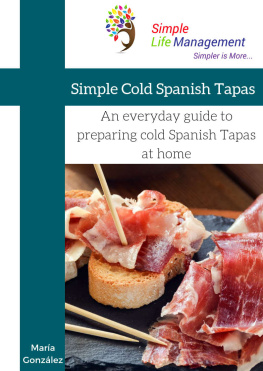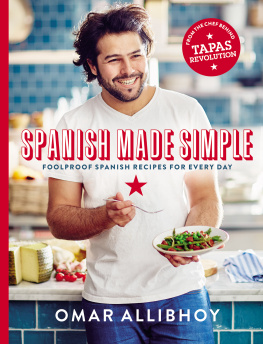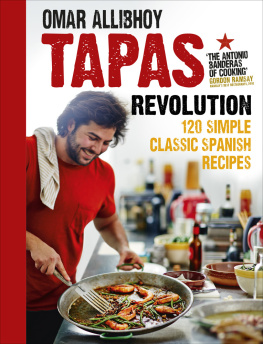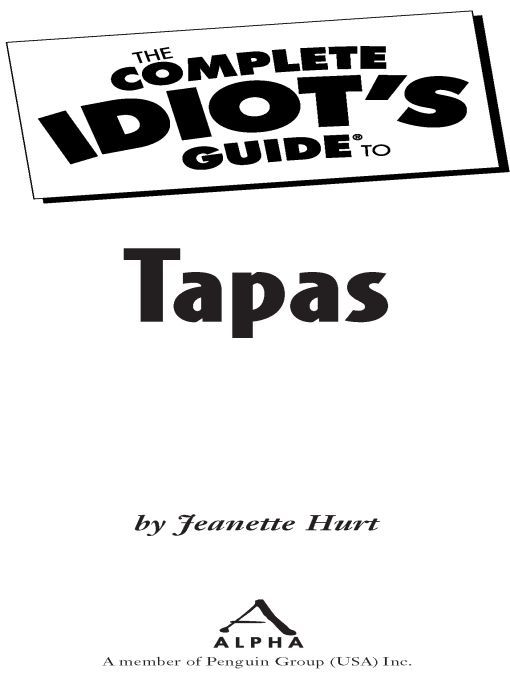Table of Contents
This book is dedicated to my parents, Tom and Mary Hurt, and my sisters, Julie
and Karen Hurt. I will never forget traveling through Spain with you.
Foreword
Tapas, tapas theyre everywhere nowadays. You cant go out without seeing small plates on the menu, whether youre at that hip new restaurant in town or the local chain down the street.
We all know that tapas are a great way to sample the food at your local eatery, but there is a lot of mystery as to where these little snacks started. Some say that in the arid climate that surrounds Andalusia, in southern Spain, it was a way for bar owners to cover the drinks of patrons and keep out bugs and dust. Tapas also had the benefit of stimulating the appetite for drinks, as most of the staples (such as ham and/or cheese on bread) were salty. As time passed and competition grew, tapas became more elaborate to draw guests in the door. Others say that tapas were created by an edict sent down by the king when he had fallen ill. It was said that to remedy his health, the king would drink wine with small bites many times a day. After he had recovered, he made it a law that no wine should be served without something to eat with it.
No matter how they began, tapas are a fun and adventurous way to sample the many different flavors of Spain. Most Spanish bars, restaurants, and ma-and-pa shops have a selection. Some places put out an elaborate spread where people pick and choose what they want as it sits on ice behind glass. Some places specialize in only one thing, which they do very well. Others let you choose from a board what you want the kitchen to send out. Yet they all have one thing in common: the act of sharing these small plates helps to stimulate conversation and bring together the people huddled around them. Known as tapeo (basically a glorified pub crawl), a group of people meet at a tapas bar just long enough to grab a quick snack and glass of wine or sherry. Then, before the stools below them have even warmed, they move on to the next bar to sample new wares.
This book is a great way to start your tapeo, or journey into this world of small plates. By no means is this book meant to be a be-all, end-all of tapas, as no book ever could be. Instead, it is meant to be a foot in the doora way to sample the huge variety of flavors from all over Spain, from the olive oil and garlic used in the hot south to the inventive combination of meat and seafood in Catalonia, to the more temperate north where apples, cabbage, and beef are abundant. It is a way for you to see the interesting flavor combinations, fantastic ingredients, and proof that Spain stands up to other gastronomic giants like France and Italy when it comes to the contribution it has made to the culinary world.
Tyge Nelson
Executive Chef
Solera Restaurant
Minneapolis, MN
Introduction
Tapas are the savory and sweet appetizers of Spain. But to call them just appetizers belies their importance. For in Spain, tapas arent just hors doeuvres, they are a way of life. Culturally significant and culinarily delicious, tapas are small dishes, meant to be shared among friends and family members. They are not just about eatingthey are about experiencing the food with loved ones.
Tapasand small plates in generalare more popular than ever before, and the necessary Spanish ingredients are more easily available than ever before. This book will share with you the history of tapas, and it will also show you how to make the most popular tapas dishes. It will also explore the culinary regions and important Spanish ingredients, as well as teach you some professional cooking techniques that will make your time in the kitchen more enjoyable.
The Complete Idiots Guide to Tapas will help you make these delectable dishes like a pro, and because youre making them yourself, they will probably taste even better because you made them. There are plenty of recipes in heremore than 100, in factfor hot and cold dishes, as well as the sweet and savory ones. It is a book to use, and if you enjoy it, by the time you finish it, it might even have a few smudge marks and corners turned downthe sign of a well-used cookbook.
And because tapas is never served without sangria or wine, and every tapas meal should be capped off with a delicious treat, this book will also introduce you to Spanish wines and desserts, too. Happy eating!
How to Use This Book
It may be trite, but the best place to start is at the beginning. Part 1, Introducing Tapas, covers just that. It not only introduces you to the history of tapas and Spanish cuisine but also introduces you to the key Spanish ingredients and cooking techniques that will make preparing tapas a breeze. Everything in this section better helps you prepare the recipes in later chapters.
Part 2, Cold Tapas, teaches you how to make the delicious appetizers that are best served chilled. This section also introduces you to some quick and easy, virtually no-cook tapas.
Part 3, Hot Tapas, tackles the techniques and recipes for creating delicious tapas that are best served warm and fresh out of the frying pan.
Part 4, The Good Life: Sweets, Drinks, and Party Tips, shows you how to throw a great tapas party, but it also introduces you to Spanish wines and sangria, as well as caps off your eating experience with some decadent desserts.
Extras
I have to admitIm a tapas geek, and I dearly love to share my knowledge and spread my enthusiasm to anyone who cares to listen. For your special benefit, Ive added some interesting tidbits and facts in each chapter, which youll find under these headings:
Hablo Tapas
Words that might be unfamiliar to you but are frequently used in Spanish are defined here.
Hot n Spicy
These are warnings about challenging or confusing details in making tapas, with tips on how to identify snafus and how to avoid them.
Tapas Tricks
The hints and tips in these boxes make cooking easier and also sometimes offer some ideas for varying a recipe.
Appetizing Extras
This is a space for little bits of interesting information. Enjoy the trivia on its ownor impress your friends with your new-found knowledge.
Acknowledgments
I could not have written this book without the loving support of my husband, Kyle Edwards. Nor would it have been as good without the generous sharing of recipes from several chefs, including: Emilio Gervilla of Emilios Restaurant in Hillside, IL; Matthew Silverman, of Vintners Grill in Las Vegas; Gregg DeRosier of the Anaba Tea Room in Milwaukee; and Dan Smith of McCormick & Schmicks Seafood Restaurant in Milwaukee. The Foods from Spain and the Trade Commission of Spain, especially Mercedes Lamami, as well as Kristina Peterson, of Weber Shandwick, and Marisa Baile, also of Weber Shandwick provided much help and useful information. I am extremely thankful to Ana Porres and the Tourism Office of Spain in Chicago, along with all of my hosts in Madrid, Segovia, and Toledo, especially Cristina de Hevia. Many of the beautiful photos in this book were taken by John Braun, a talented photographer who also happens to be married to Dena Braun, an equally talented writer (Check out more beautiful photos of Spain at www.fitglobetrotter.com). I also owe a huge debt of gratitude and a pitcher of sangria to the Kitchen Chicas, my dear friends and family members who either graciously allowed me to include their recipes or who helped me test my recipes: Sarah Dowhower, Marcie Hutton, Karen Hurt, Tamara Johnston, Karen Malhiot, Julie Neubauer, Ranjana Patnaik, Jeanne Potter, Lisa Stardy, and Amy Vuyk. Thanks to Damon Brown, my writing buddy, Marilyn Allen, my fantastic agent, and my wonderful editor, Michele Wells and the other talented people at Alpha Books including development editor Ginny Munroe, production editor Megan Douglass, and copy editor Nancy Wagner. I would also like to thank Ramona Serrandilla, who taught me what real












